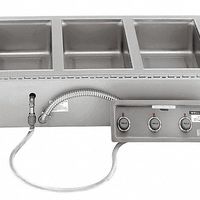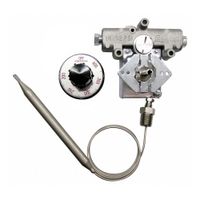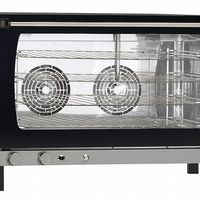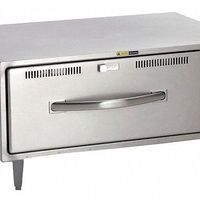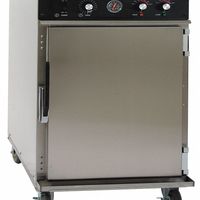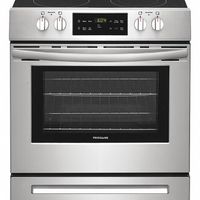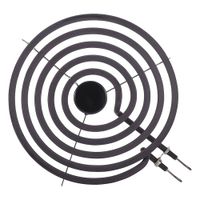Call +(254) 703 030 000 / 751 483 999 / 721 704 777
- Home
- Furnishings Appliances Hospitality
- Appliances
- Ovens Warming Equipment
Frequently Asked Questions
What is the difference between a convection oven and a regular oven?
A convection oven and a regular oven differ primarily in how they circulate heat. A regular oven, also known as a conventional oven, relies on radiant heat from the top and bottom heating elements. This can result in uneven cooking, as hot air tends to rise, creating temperature variations within the oven.
In contrast, a convection oven is equipped with a fan and exhaust system that circulates hot air throughout the oven cavity. This promotes even heat distribution, reducing cooking times and allowing food to cook more uniformly. The consistent airflow in a convection oven can lead to better browning and crisping of foods, making it ideal for roasting meats and baking pastries.
Convection ovens often have a setting to toggle the fan on or off, allowing them to function as regular ovens when needed. This versatility can be advantageous for recipes that require specific cooking conditions.
When using a convection oven, it's generally recommended to lower the cooking temperature by about 25 degrees Fahrenheit compared to a regular oven, and to check for doneness earlier, as cooking times can be shorter.
Overall, the main differences lie in heat distribution and cooking efficiency, with convection ovens offering more even cooking and potentially faster results.
How do I choose between a gas and electric oven range?
When choosing between a gas and electric oven range, consider the following factors:
1. **Cooking Performance**: Gas ranges offer instant heat and precise temperature control, ideal for stovetop cooking. Electric ovens provide even, consistent heat, which is beneficial for baking.
2. **Cost**: Gas ranges typically have a higher upfront cost but may be cheaper to operate if natural gas is less expensive than electricity in your area. Electric ranges are generally less expensive initially but can have higher operating costs.
3. **Installation**: Gas ranges require a gas line, which can increase installation costs if one is not already available. Electric ranges need a 240-volt outlet, which is standard in most kitchens.
4. **Energy Efficiency**: Electric ovens are generally more energy-efficient for baking, while gas ranges are more efficient for stovetop cooking.
5. **Cooking Habits**: If you frequently bake, an electric oven might be preferable for its even heat distribution. For those who prioritize stovetop cooking, a gas range offers better control.
6. **Safety**: Electric ranges eliminate the risk of gas leaks, but gas ranges cool down faster after use, reducing burn risks.
7. **Environmental Impact**: Electric ranges can be more environmentally friendly if your electricity comes from renewable sources. Gas ranges rely on fossil fuels.
8. **Availability**: In some areas, gas may not be available, making an electric range the only option.
9. **Maintenance**: Gas ranges may require more maintenance due to burner and ignition issues, while electric ranges can have problems with heating elements.
10. **Aesthetics and Features**: Consider the design and additional features like convection settings, self-cleaning, and smart technology.
Evaluate these factors based on your personal preferences, budget, and cooking needs to make an informed decision.
What are the benefits of using a countertop convection oven?
A countertop convection oven offers several benefits that make it a versatile and efficient kitchen appliance:
1. **Even Cooking**: The fan and exhaust system in a convection oven circulate hot air around the food, ensuring even cooking and browning. This reduces the risk of hot spots and results in uniformly cooked dishes.
2. **Faster Cooking Times**: The efficient air circulation allows food to cook faster than in a traditional oven. This can save time, especially for busy households or when preparing multiple dishes.
3. **Energy Efficiency**: Because it cooks food more quickly and at lower temperatures, a convection oven uses less energy than a conventional oven, which can lead to cost savings on utility bills.
4. **Versatility**: Countertop convection ovens can perform a variety of cooking functions, including baking, roasting, toasting, and broiling. Some models also offer additional features like air frying and dehydrating.
5. **Space-Saving**: These ovens are compact and can fit on a kitchen countertop, making them ideal for small kitchens, apartments, or dorm rooms where space is limited.
6. **Improved Texture and Flavor**: The consistent heat distribution helps achieve a crispy exterior while keeping the interior moist, enhancing the texture and flavor of foods like roasted meats and baked goods.
7. **Reduced Cooking Odors**: The exhaust system helps to minimize cooking odors, keeping the kitchen smelling fresh.
8. **Convenience**: With easy-to-use controls and quick preheating, countertop convection ovens offer convenience for everyday cooking tasks.
9. **Portability**: Being relatively lightweight and compact, these ovens can be easily moved or stored when not in use.
10. **Less Heat in the Kitchen**: They generate less ambient heat compared to full-sized ovens, which is beneficial during hot weather or in small spaces.
How do I maintain and clean my oven range?
To maintain and clean your oven range, follow these steps:
1. **Regular Wiping**: After each use, wipe down the stovetop with a damp cloth to remove spills and crumbs. Use a mild detergent for greasy spots.
2. **Deep Cleaning the Stovetop**: Remove burner grates and caps. Soak them in warm, soapy water. Scrub with a non-abrasive brush, rinse, and dry. For electric ranges, remove and clean drip pans.
3. **Cleaning the Oven Interior**: Use the self-cleaning function if available, following the manufacturer's instructions. For manual cleaning, apply a paste of baking soda and water to the interior surfaces, avoiding heating elements. Let it sit overnight, then wipe with a damp cloth. Use vinegar to remove any residue.
4. **Cleaning Oven Racks**: Remove racks and soak them in warm, soapy water. Scrub with a brush, rinse, and dry thoroughly.
5. **Control Knobs and Panel**: Remove knobs if possible and clean with soapy water. Wipe the control panel with a damp cloth, avoiding excess moisture.
6. **Exterior Cleaning**: Wipe the exterior with a damp cloth and mild detergent. For stainless steel surfaces, use a stainless steel cleaner or a mixture of vinegar and water.
7. **Vent and Hood Maintenance**: Clean the range hood filter by soaking it in hot, soapy water. Scrub and rinse. Wipe the hood exterior with a degreaser.
8. **Check Seals and Gaskets**: Inspect door seals for damage. Clean them with a damp cloth to ensure a proper seal.
9. **Regular Inspection**: Periodically check for gas leaks (if applicable) and ensure all components are functioning properly.
10. **Professional Servicing**: Schedule annual maintenance with a professional to ensure safety and efficiency.
By following these steps, you can keep your oven range clean and in good working condition.
What are the safety tips for using commercial cooking appliances?
1. **Read the Manual**: Familiarize yourself with the manufacturer's instructions and safety guidelines for each appliance.
2. **Regular Maintenance**: Schedule routine inspections and maintenance to ensure appliances are in good working condition.
3. **Proper Installation**: Ensure appliances are installed by qualified professionals to prevent gas leaks or electrical hazards.
4. **Ventilation**: Maintain adequate ventilation to prevent the buildup of smoke, steam, and carbon monoxide.
5. **Fire Suppression Systems**: Install and regularly check fire suppression systems and ensure staff know how to operate them.
6. **Use Correct Fuel**: Only use the recommended type of fuel or power source for each appliance.
7. **Keep Clean**: Regularly clean appliances to prevent grease buildup, which can be a fire hazard.
8. **Monitor Temperatures**: Use thermometers to ensure appliances are operating at safe temperatures.
9. **Avoid Overloading**: Do not overload appliances beyond their capacity to prevent overheating and damage.
10. **Use Protective Gear**: Wear appropriate protective clothing, such as gloves and aprons, to prevent burns and injuries.
11. **Clear Surroundings**: Keep flammable materials away from heat sources and ensure workspaces are clutter-free.
12. **Emergency Procedures**: Train staff on emergency procedures, including how to shut off appliances and use fire extinguishers.
13. **Electrical Safety**: Ensure all electrical connections are secure and appliances are grounded to prevent shocks.
14. **Gas Safety**: Regularly check for gas leaks and ensure gas lines are secure.
15. **Child Safety**: Keep children away from cooking areas to prevent accidents.
16. **First Aid**: Have a first aid kit readily available and ensure staff are trained in basic first aid.
17. **Stay Alert**: Never leave cooking appliances unattended while in use.
How do I properly store cooked food to keep it warm?
To properly store cooked food and keep it warm, follow these steps:
1. **Use a Warming Drawer or Oven**: If available, set a warming drawer or oven to a low temperature (around 140°F or 60°C) to keep food warm without overcooking. Cover the food with foil to prevent drying.
2. **Chafing Dishes**: For buffets or gatherings, use chafing dishes with Sterno cans to maintain warmth. Ensure the water in the pan is hot before placing the food tray on top.
3. **Slow Cooker**: Transfer food to a slow cooker set to the "warm" setting. This is ideal for soups, stews, and casseroles.
4. **Thermal Insulated Containers**: For transporting or short-term storage, use thermal insulated containers or food warmers. Preheat the container with hot water before adding the food.
5. **Aluminum Foil and Towels**: Wrap food in aluminum foil and then in towels to retain heat. This method is suitable for short periods and when other equipment is unavailable.
6. **Heat Lamps**: In professional settings, use heat lamps to keep food warm on a serving line. Ensure the food is not exposed for too long to prevent drying.
7. **Microwave**: For quick reheating, use a microwave-safe cover to keep moisture in while warming food.
8. **Avoid Overcrowding**: When storing multiple dishes, avoid stacking them too closely to ensure even heat distribution.
9. **Monitor Temperature**: Use a food thermometer to ensure food stays above 140°F (60°C) to prevent bacterial growth.
10. **Serve Promptly**: Whenever possible, serve food immediately after cooking to maintain optimal temperature and quality.
By following these methods, you can effectively keep cooked food warm while maintaining its quality and safety.
What features should I look for in cooking appliance controls?
When selecting cooking appliances, consider the following features in their controls:
1. **Ease of Use**: Controls should be intuitive and easy to operate. Look for clear labeling, simple interfaces, and user-friendly designs.
2. **Precision**: Ensure the controls allow for precise temperature and time settings. Digital controls often offer more accuracy than analog ones.
3. **Programmability**: Some appliances offer programmable settings for specific cooking tasks, which can save time and ensure consistent results.
4. **Safety Features**: Look for controls with safety features such as child locks, automatic shut-off, and overheat protection to prevent accidents.
5. **Durability**: Controls should be made from high-quality materials that can withstand frequent use and exposure to heat and moisture.
6. **Feedback Mechanisms**: Features like indicator lights, audible alerts, and digital displays provide feedback on the appliance’s status and settings.
7. **Touch vs. Knob Controls**: Decide between touch controls, which offer a sleek look and are easy to clean, and knob controls, which provide tactile feedback and are often easier to use with wet or greasy hands.
8. **Smart Features**: Consider appliances with smart controls that can be operated via smartphone apps, offering remote operation and monitoring.
9. **Customizability**: Some appliances allow you to customize control settings to suit your cooking preferences and habits.
10. **Backlighting**: Backlit controls are easier to see in low-light conditions, enhancing usability.
11. **Responsive Controls**: Ensure that the controls respond quickly to inputs without lag, providing a seamless cooking experience.
12. **Ergonomics**: Controls should be positioned for easy access and comfortable use, reducing strain during operation.
By focusing on these features, you can choose cooking appliances with controls that enhance functionality, safety, and convenience in your kitchen.
